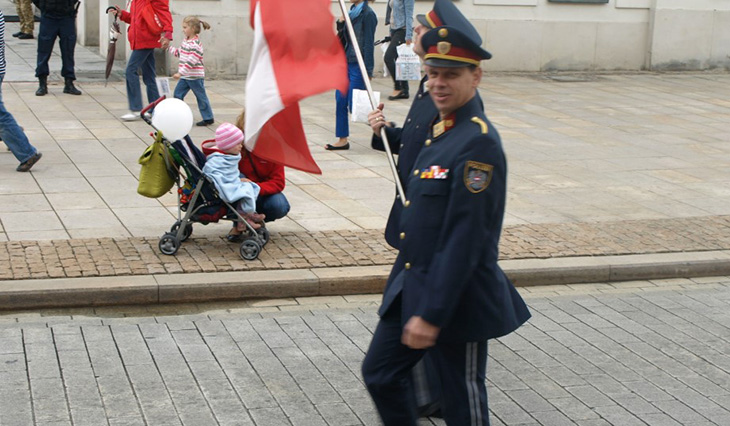China On The Verge: Welfare State Crumbles, Explosion In Social Unrest As Youth Unemployment Soars, Strikes Surge
In retrospect, it was clear that the bottom was falling out of China’s economy (the real economy, not the fake „as reported” one) last August when shortly after we learned that youth unemployment in the country hit a record 21.3%, Beijing unexpectedly stopped reporting this data entirely, because as Stalin would probably say today if he were still alive, „No data – no problem”!
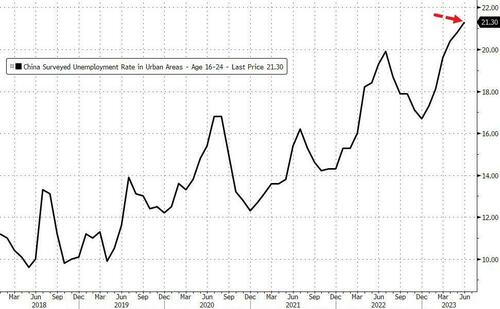
Since then, largely as a result of Xi Jinping’s insistence not to stimulate the economy no matter the severity of the deterioration, China’s economy has accelerated down its perilous slowdown. And while Wall Street has gladly assumed that Beijing will be able to get away without a forceful stimulus for the foreseeable future even as GDP ticks down from 5% to 4% to 3% to… you get the picture, a far more credible – and unpleasant – argument for a bazooka stimulus is rearing its ugly head: social cohesion is about to crack.
We start where we left off last August, with China’s surging youth unemployment rate. Here, as the South China Morning Post reports, China’s revised youth unemployment surged to 17.2% in July (this would be the equivalent of about 23% according to the old series), the highest level since the National Bureau of Statistics adopted a new method of counting.
The jobless rate for 16- to 24-year-olds (excluding students) was up from 13.2% a month earlier and ended three months of declines, according to the latest NBS data. The rate for December was 14.9%.
As we reported last year, Beijing introduced the revised method for December after suspending the release of youth unemployment data from July. Under the previous approach, the jobless rate for the 16-24 age group, including students, peaked at 21.3 per cent in June.
Student numbers were then stripped out of the calculation, a change that the NBS said was to “more accurately” reflect that job-hunting was not a priority for students in China. That, however, is a major problem, as it does not account for the relentless firehose of new entrants that enter the labor market every year when millions of Chinese students graduate and start looking for a job.
Indeed, as SCMP reports, the rise in unemployment among young jobseekers comes as a record 11.79 million tertiary graduates enter the labor market of the world’s second-largest economy!
As a result, many fresh graduates have had to scale back salary expectations by about a third as the economy has struggled to gather momentum, according to analysts. One day before the youth jobless reading, the NBS reported that the country’s overall unemployment rate was 5.2%, up for the first time since February.
“The employment situation has remained generally stable so far this year,” NBS spokeswoman Liu Aihua said, “but we should also see at the same time that pressure … still exists. The structural contradiction of difficulties in both job seeking and recruitment is still prominent.”
Realizing that tens of millions of unemployed yutes is recipe for revolution, China’s ruling elites have put far more emphasis on dealing with youth joblessness this year – starting with adjusting how it is misreported of course to prevent all out chaos – in part because of the risks it poses to social stability as well as the pressure lower incomes would put on plans for consumer spending to lead the way to a sustainable recovery.
At a meeting of the State Council, the country’s cabinet, last Friday, Premier Li Qiang called for more efforts to “stabilize employment for key groups”. The Communist Party’s Politburo, the main decision-making body in China, had a similar message two weeks earlier, saying priority should be given to university graduates looking for jobs.
And last month the party’s Central Committee said it would “improve the system of employment support for key groups such as college graduates, rural migrant workers and ex-service members”.
Which brings us to even more data fudging: since the release of the December data, the Chinese authorities have split the 25-59 age group into two parts – 25-29 and 30-59 – and applied the new statistical method to both.
The jobless rate for the 25-29 age group, also excluding students, was 6.5% in July, up by 0.1% from June, inching back up after three consecutive months of decline. The rate for the 30-59 age group was 3.9%, just down from 4% reported in June.
Unfortunately for Beijing, literally nobody believes these numbers, because instead of a picture of economic stability, China now exudes an unprecedented slowdown, one where labor disputes in China’s property and manufacturing sectors have surged as economic growth decelerates, underlining blue-collar workers’ concerns over the country’s social safety net.
As Nikkei reported last week, while „unrest is rarely reported by the country’s media due to strict government control, signs of public discontent and hardship emerge nonetheless.”
Recent incidents include a protest by an ex-soldier who sat atop a building in Beijing’s famed Wangfujing shopping street on the evening of Aug. 1. In a video uploaded on the social media platform X, the man in full army uniform unveils a white banner accusing a government office in the city of Kunming, Yunnan province, of „strangling a retired serviceman who had served for 12 years.”
Two days earlier, another protester displayed a banner on an overpass in the county of Xinhua, Hunan province, demanding freedom and elections. In an accompanying video that spread on X, the protester identified himself as Fang Yirong and claimed to have been targeted by authorities since last summer for supporting democracy. He said he took part in the „white paper” protests in 2022 against China’s harsh COVID-19 restrictions.
Meanwhile, labor strikes in China increased 3% on the year to 719 incidents in the first half of 2024, according to the China Labor Bulletin (CLB), a Hong Kong-based workers advocacy group.
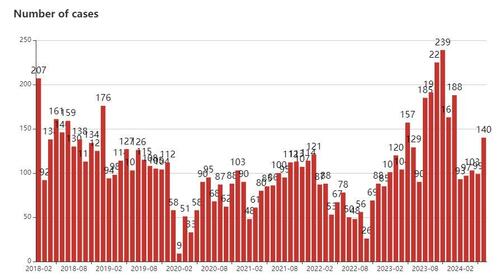
Incidents involving the all-important property and manufacturing sectors were up 12%, accounting for 80% of the total.
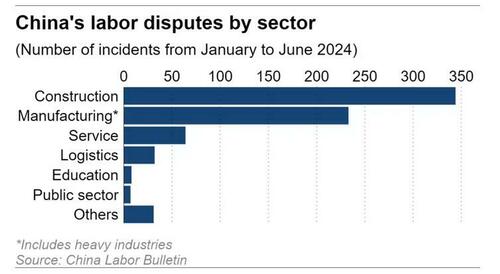
„The uptick in strikes is a reflection of the increasing social pressure as the economy struggles to improve,” said Max J. Zenglein, chief economist at the Mercator Institute for China Studies in Germany.
China’s economic growth slowed to 4.7% in the second quarter, from 5.3% in the first, stifled by a persistent downturn in the property sector, which is going from bad to worse seemingly every single month as we will discuss in a subsequent post, and subdued household demand. Sluggish domestic growth has pushed some industries, including solar panels and automobiles, to step up exports and price dumping, sparking howls of outrage from domestic producers in export markets, while those hit by trade tensions with the U.S. have sought to shift production abroad.
Worker unrest appears to reflect the growing pressures. Among the incidents highlighted in the CLB report was a dispute at solar panel maker Akcome Technology over pay cuts and withdrawal of social security contributions. The Shenzhen-listed Akcome filed for bankruptcy at one of its subsidiaries on July 29, citing an inability to repay debts.
While there was no indication of the number of protesters at Akcome, CLB in a separate report profiled a strike involving over 1,000 workers at a shoe factory in Jiangsu province that counts Nike, Adidas, Asics, New Balance, Timberland and Salomon among its clients. The dispute at Yangzhou Baoyi Shoe Manufacturing in November took place over compensation issues affecting laid-off workers after the company moved its production to Indonesia.
„So far in 2024 there has been no notable improvement of the economy, with a weak labor market being a key source of household insecurity that is weighing down on consumption,” said Zenglein.
The largest proportion of protests — 344 incidents — were carried out by construction workers demanding wages, according to CLB. This is no surprise, said Zenglein, given the growing number of property developers that have run into financial trouble who are unable to pay their employees, resulting in chaos and ripple effects through the economy.
China’s strikes are usually by workers who face long working hours and low wages, CLB said. This also casts a light on the disparity in social security coverage between urban and migrant workers. Unlike people with a registered household in a city, many laborers from rural areas work without formal contracts despite forming the economic backbone of their adopted cities.
„It is difficult for migrant workers to find jobs that pay for social security for 15 years, the prerequisite for getting pension when retired,” the report said.
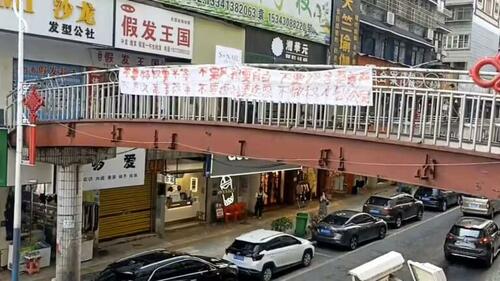 This scene from a video posted on X shows a banner criticizing Chinese President Xi Jinping in Xinhua, Hunan province.
This scene from a video posted on X shows a banner criticizing Chinese President Xi Jinping in Xinhua, Hunan province. As migrant workers are largely excluded from such welfare coverage altogether, „work becomes the hedge against an extremely porous social safety net,” said Yun Zhou, a social demographer and family sociologist at the University of Michigan. These workers „are confronting a harsh, discriminatory labor landscape where work availability is highly susceptible to China’s economic downturn and restructuring, working conditions are often at the will of capricious management, and workers’ productivity and worth are tightly managed by technology and algorithms.”
In a key socioeconomic planning meeting concluded last month, the government vowed to improve the social security system by addressing the restrictions faced by migration workers. In response to the country’s aging population, it added that the statutory retirement age — currently 60 years for men and between 50 and 55 for women — would be raised gradually and voluntarily. Of course, there has been no centrally-planned civilization in history that managed to raise the retirement age either „voluntarily” and without clashes, violence, and collapse in social cohesion, precisely the three things that Beijing fears the most.
„For China’s urban workers, the talk of raising retirement ages is felt as a delayed, if not broken, promise of social welfare coverage,” said Zhou.
Which is precisely why Beijing will have no choice but to blink in the end, and that will mean unleashing a much delayed stimulus bazooka that likes of which have not been seen yet.
Tyler Durden
Tue, 08/20/2024 – 16:40











